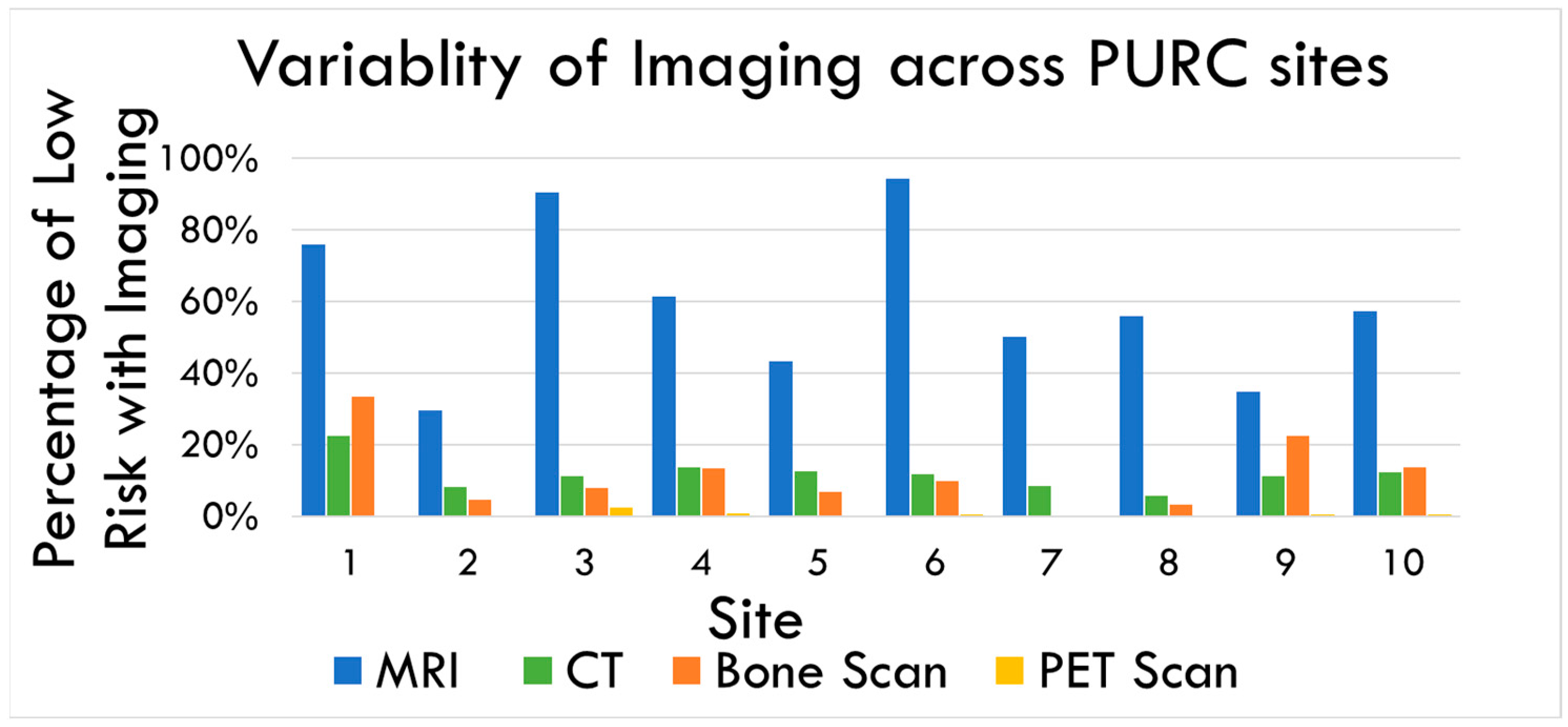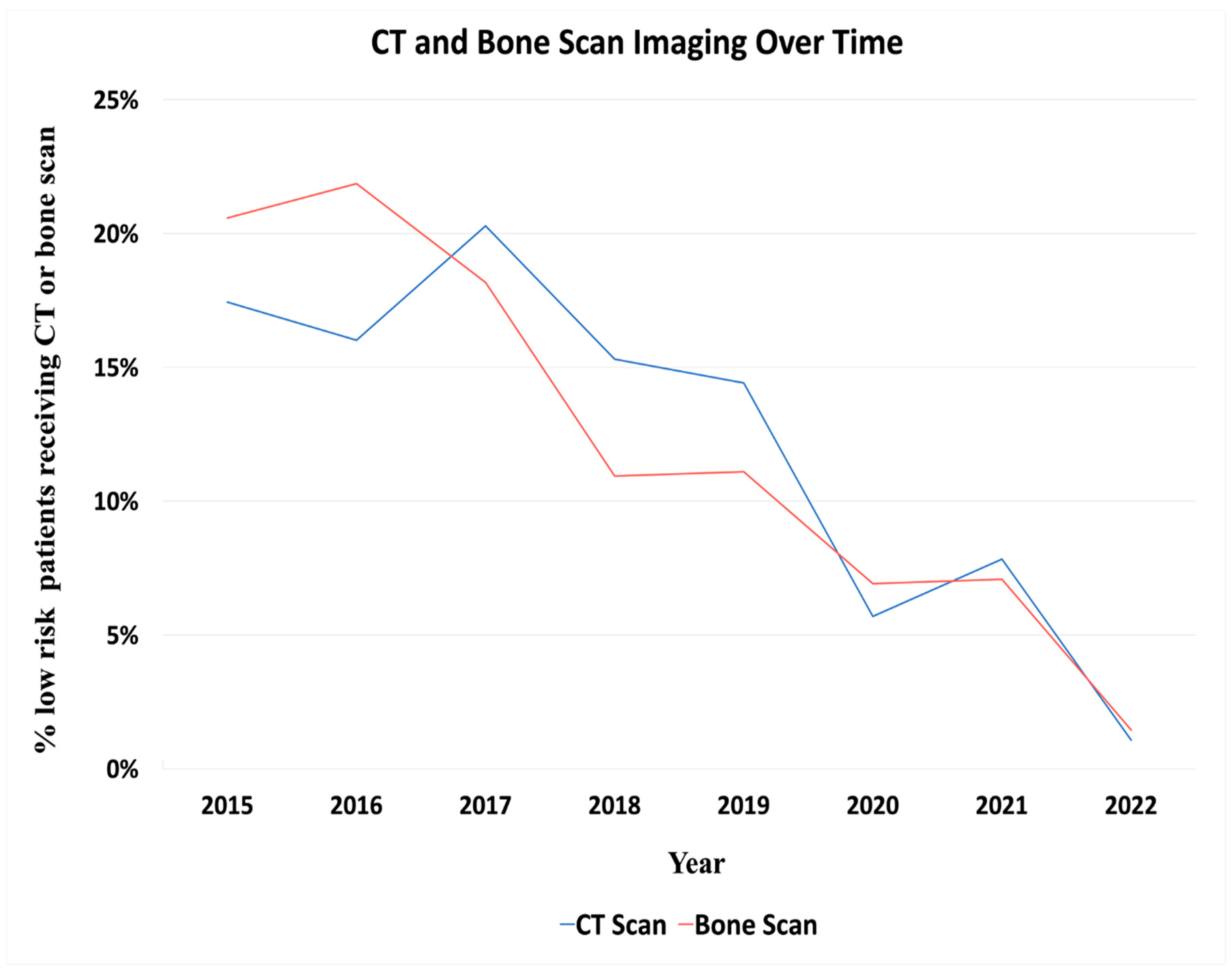Appropriateness of Imaging for Low-Risk Prostate Cancer—Real World Data from the Pennsylvania Urologic Regional Collaboration (PURC)
Abstract
1. Introduction
2. Materials and Methods
3. Results
4. Discussion
5. Conclusions
Author Contributions
Funding
Institutional Review Board Statement
Informed Consent Statement
Data Availability Statement
Conflicts of Interest
References
- Merdan, S.; Womble, P.R.; Miller, D.C.; Barnett, C.; Ye, Z.; Linsell, S.M.; Montie, J.E.; Denton, B.T. Toward better use of bone scans among men with early-stage prostate cancer. Urology 2014, 84, 793–798. [Google Scholar] [CrossRef] [PubMed]
- Risko, R.; Merdan, S.; Womble, P.R.; Barnett, C.; Ye, Z.; Linsell, S.M.; Montie, J.E.; Miller, D.C.; Denton, B.T. Clinical predictors and recommendations for staging computed tomography scan among men with prostate cancer. Urology 2014, 84, 1329–1334. [Google Scholar] [CrossRef] [PubMed]
- Makarov, D.V.; Trock, B.J.; Humphreys, E.B.; Mangold, L.A.; Walsh, P.C.; Epstein, J.I.; Partin, A.W. Updated nomogram to predict pathologic stage of prostate cancer given prostate-specific antigen level, clinical stage, and biopsy Gleason score (Partin tables) based on cases from 2000 to 2005. Urology 2007, 69, 1095–1101. [Google Scholar] [CrossRef] [PubMed]
- Courtney, P.T.; Deka, R.; Kotha, N.V.; Cherry, D.R.; Salans, M.A.; Nelson, T.J.; Kumar, A.; Luterstein, E.; Yip, A.T.; Nalawade, V.; et al. Metastasis and Mortality in Men With Low- and Intermediate-Risk Prostate Cancer on Active Surveillance. J. Natl. Compr. Canc. Netw. 2022, 20, 151–159. [Google Scholar] [CrossRef]
- Eastham, J.A.; Auffenberg, G.B.; Barocas, D.A.; Chou, R.; Crispino, T.; Davis, J.W.; Eggener, S.; Horwitz, E.M.; Kane, C.J.; Kirkby, E.; et al. Clinically Localized Prostate Cancer: AUA/ASTRO Guideline, Part I: Introduction, Risk Assessment, Staging, and Risk-Based Management. J. Urol. 2022, 208, 10–18. [Google Scholar] [CrossRef]
- Alshehri, S.Z.; Safar, O.; Almsaoud, N.A.; Al-Ghamdi, M.A.; Alqahtani, A.M.; Almurayyi, M.M.; Autwdi, A.S.; Al-Ghamdi, S.A.; Zogan, M.M.; Alamri, A.M. The role of multiparametric magnetic resonance imaging and magnetic resonance-guided biopsy in active surveillance for low-risk prostate cancer: A systematic review. Ann. Med. Surg. 2020, 57, 171–178. [Google Scholar] [CrossRef]
- Lange, S.M.; Choudry, M.M.; Hunt, T.C.; Ambrose, J.P.; Haaland, B.A.; Lowrance, W.T.; Hanson, H.A.; O’Neil, B.B. Impact of choosing wisely on imaging in men with newly diagnosed prostate cancer. Urol. Oncol. 2023, 41, 48.e19–48.e26. [Google Scholar] [CrossRef] [PubMed]
- Schnipper, L.; Smith, T.; Raghavan, D.; Blayney, D.; Ganz, P.; Mulvey, T.; Wollins, D. American society of clinical oncology identifies five key opportunities to improve care and reduce costs: The top five list for oncology. J. Clin. Oncol. 2012, 30, 1715–1724. [Google Scholar] [CrossRef] [PubMed]
- Makarov, D.V.; Loeb, S.; Ulmert, D.; Drevin, L.; Lambe, M.; Stattin, P. Prostate cancer imaging trends after a nationwide effort to discourage inappropriate prostate cancer imaging. JNCI J. Natl. Cancer Inst. 2013, 105, 1306–1313. [Google Scholar] [CrossRef]
- Pettit, S.; Mikhail, D.; Feuerstein, M. Systematic review of interventions that improve provider compliance to imaging guidelines for prostate cancer. Can. Urol. Assoc. J. 2022, 16, E490. [Google Scholar] [CrossRef] [PubMed]
- Prasad, S.M.; Gu, X.; Lipsitz, S.R.; Nguyen, P.L.; Hu, J.C. Inappropriate utilization of radiographic imaging in men with newly diagnosed prostate cancer in the united states. Cancer 2011, 118, 1260–1267. [Google Scholar] [CrossRef] [PubMed]
- Shao, W.; Bhattacharya, I.; Soerensen SJ, C.; Kunder, C.A.; Wang, J.B.; Fan, R.E.; Ghanouni, P.; Brooks, J.D.; Sonn, G.A. Weakly supervised registration of prostate mri and histopathology images. In Proceedings of the Medical Image Computing and Computer Assisted Intervention–MICCAI 2021: 24th International Conference, Strasbourg, France, 27 September–1 October 2021. [Google Scholar] [CrossRef]
- Pepe, P.; Pepe, L.; Cosentino, S.; Ippolito, M.; Pennisi, M.; Fraggetta, F. Detection Rate of 68Ga-PSMA PET/CT vs. mpMRI Targeted Biopsy for Clinically Significant Prostate Cancer. Anticancer. Res. 2022, 42, 3011–3015. [Google Scholar] [CrossRef] [PubMed]


Disclaimer/Publisher’s Note: The statements, opinions and data contained in all publications are solely those of the individual author(s) and contributor(s) and not of MDPI and/or the editor(s). MDPI and/or the editor(s) disclaim responsibility for any injury to people or property resulting from any ideas, methods, instructions or products referred to in the content. |
© 2024 by the authors. Licensee MDPI, Basel, Switzerland. This article is an open access article distributed under the terms and conditions of the Creative Commons Attribution (CC BY) license (https://creativecommons.org/licenses/by/4.0/).
Share and Cite
Mercedes, R.; Head, D.; Zook, E.; Eidelman, E.; Tomaszewski, J.; Ginzburg, S.; Uzzo, R.; Smaldone, M.; Danella, J.; Guzzo, T.J.; et al. Appropriateness of Imaging for Low-Risk Prostate Cancer—Real World Data from the Pennsylvania Urologic Regional Collaboration (PURC). Curr. Oncol. 2024, 31, 4746-4752. https://doi.org/10.3390/curroncol31080354
Mercedes R, Head D, Zook E, Eidelman E, Tomaszewski J, Ginzburg S, Uzzo R, Smaldone M, Danella J, Guzzo TJ, et al. Appropriateness of Imaging for Low-Risk Prostate Cancer—Real World Data from the Pennsylvania Urologic Regional Collaboration (PURC). Current Oncology. 2024; 31(8):4746-4752. https://doi.org/10.3390/curroncol31080354
Chicago/Turabian StyleMercedes, Raidizon, Dennis Head, Elizabeth Zook, Eric Eidelman, Jeffrey Tomaszewski, Serge Ginzburg, Robert Uzzo, Marc Smaldone, John Danella, Thomas J. Guzzo, and et al. 2024. "Appropriateness of Imaging for Low-Risk Prostate Cancer—Real World Data from the Pennsylvania Urologic Regional Collaboration (PURC)" Current Oncology 31, no. 8: 4746-4752. https://doi.org/10.3390/curroncol31080354
APA StyleMercedes, R., Head, D., Zook, E., Eidelman, E., Tomaszewski, J., Ginzburg, S., Uzzo, R., Smaldone, M., Danella, J., Guzzo, T. J., Lee, D., Belkoff, L., Walker, J., Reese, A., Shah, M. S., Jacobs, B., & Raman, J. D. (2024). Appropriateness of Imaging for Low-Risk Prostate Cancer—Real World Data from the Pennsylvania Urologic Regional Collaboration (PURC). Current Oncology, 31(8), 4746-4752. https://doi.org/10.3390/curroncol31080354




